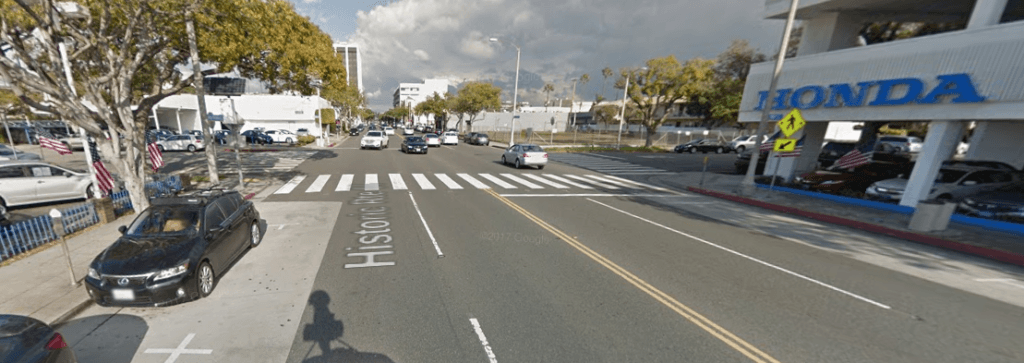
The Santa Monica City Council will look at traffic safety tonight, just more than a month after a particularly shocking streak of traffic-related deaths rocked the beachside city.
The report was placed on the agenda after a request from Councilmembers Terry O’Day, Pam O’Connor, and Mayor Ted Winterer in February. Less than a month later began a series of unrelated traffic collisions that would, over the course of five weeks, leave as many people dead.
The Council’s request in February “took on greater urgency when the City experienced a cluster of vehicle/pedestrian collisions that resulted in severe injuries and, for some of the victims, death,” according to the staff report on the city’s website.
While these five crashes garnered much media attention, fatal crashes are not all that uncommon in the city.
“Between 2006 and 2016, Santa Monica traffic collisions resulted in an average of 26 fatalities and severe injuries among all roadway users,” according to the city’s staff report.

The vast majority of those collisions — 82 percent — are vehicle collisions, according to staff. However, 70 percent of the reported deaths resulting from traffic collisions come out of the remaining 18 percent of collisions that involve people walking or biking.
“Incidents are happening throughout Santa Monica, primarily on major thoroughfares with the highest volume of traffic. Major collision factors are unsafe speeds and right-of-way violations, and SMPD citations are written in a similar proportion to violations,” according to the staff report. “In addition to enforcement, City staff actively engages the community to encourage safe behaviors on the road in meetings, videos, and print media.”
Last year, the Santa Monica City Council adopted a Pedestrian Action Plan, modeled on the now six-year-old Bike Action Plan, and with it, a policy of Vision Zero, the principle that the city’s top priority should be the elimination of major injuries and deaths resulting from traffic crashes.
However, the city of Los Angeles, which also recently adopted a Vision Zero policy, is taking much a much more aggressively progressive approach to street safety than Santa Monica by addressing one of the root causes of unsafe roads: the way they are designed to encourage high speeds. Currently a proposal, spearheaded by L.A. Councilmember Mike Bonin, to allocate the lion’s share of the estimated $66 million Los Angeles will receive as local return funds from Measure M to Vision Zero implementation.
According to Streetsblog LA, Bonin’s funding proposal breaks down as follows:
- 60 percent for Vision Zero
- 20 percent for essentially Vision Zero curb-work “median island and curb extension improvements, including but not limited to bus bulbs, curb extensions, pedestrian refuge and median islands”
- 10 percent for sidewalk repair and reconstruction on Vision Zero High Injury Network corridors
- 10 percent for upgrade and expansion of bicycle infrastructure
Santa Monica city staff in their report actually pointed to L.A.’s approach as a possible model:
“Los Angeles defined a ‘high-injury street network’ of roadways prioritized for design changes and speed management to reduce the severity of injuries when crashes occur. Elected officials and other leaders need to courageously lead efforts for street design and operations that prioritize safety and manage speeds, even when resistance arises due to non-safety concerns such as parking and large vehicle access. Los Angeles is currently pursuing investing all of the Measure M Local Return funds into Vision Zero projects,” city staff wrote.
Other recommendations in the report include, “Build and sustain leadership,” “Create a Task Force for interagency collaboration,” “Develop and adopt a Vision Zero Action Plan,” “Create an interagency communication and education campaign for Vision Zero,” and “Collect, Analyze and Use Data to inform action, and share it.”
Even so, there are several lines in the report that suggest implementing the actual Vision Zero policies is going to be a heavy lift politically.
“There are vocal advocates for each mode of transportation (including, especially, the automobile),” the staff report reads. “Remaking the street network to equalize access and promote shared usage and safety requires not only substantial financial commitment, but equally substantial commitment to ongoing management, public engagement and education — as well as the political will to take the long view of change in the face of vigorous defense of the status quo when it comes to street design, parking policy and traffic enforcement.”
Compared to Los Angeles and other cities, like Seattle and Portland, Santa Monica appears to be falling behind as a progressive standard-bearer. It remains to be seen if the will exists for it to catch up.
